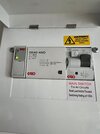Snagsy1980
New Member
Hello,
I have a Shell NewMotion Advanced EV chargepoint installed at my house. It's wired into a GARO unit which has an RCBO B40AS and a GK40 4NO relay before it hits the main fusebox of the house into a fusebox B32 MCB.
The problem i'm seeing is the relay in the GARO unit, it's energising and de energising at seemingly random times. So for example if the RCBO is tripped on the GARO and the MCB is tripped, MCB powered on then RCBO powered on the light comes on but it doesn't energise the relay, if i do it again a few moments later it may energise the relay when that's done.
The GARO unit has been changed 2 times now but this weird behaviour isn't going away. can someone help me to troubleshoot it?
I didn't install this btw, it was done by a firm who specialise in EV charger installs. I am not an electrician but i do understand electrics, i'm a former RAF avionics engineer who served 10 years and left in 2007 so electrical theory and repairs was a LONG time ago
I have a Shell NewMotion Advanced EV chargepoint installed at my house. It's wired into a GARO unit which has an RCBO B40AS and a GK40 4NO relay before it hits the main fusebox of the house into a fusebox B32 MCB.
The problem i'm seeing is the relay in the GARO unit, it's energising and de energising at seemingly random times. So for example if the RCBO is tripped on the GARO and the MCB is tripped, MCB powered on then RCBO powered on the light comes on but it doesn't energise the relay, if i do it again a few moments later it may energise the relay when that's done.
The GARO unit has been changed 2 times now but this weird behaviour isn't going away. can someone help me to troubleshoot it?
I didn't install this btw, it was done by a firm who specialise in EV charger installs. I am not an electrician but i do understand electrics, i'm a former RAF avionics engineer who served 10 years and left in 2007 so electrical theory and repairs was a LONG time ago




